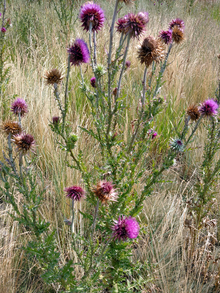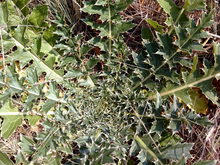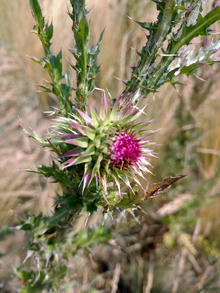Quick facts
Musk thistle is an invasive species.
- Musk thistle colonizes in disturbed areas, such as pastures, roadside ditches, ditch banks, hayfields and disturbed prairies.
- Seeds detach quickly and don’t fall far from parent plant, creating monoculture carpet.
- Livestock do not eat it, giving it a competitive edge against native species.
Musk thistle should be reported. The Minnesota Department of Natural Resources provides detailed recommendations for reporting invasive species.
How to identify musk thistle
- Musk thistle (Carduus nutans) is a biennial herbaceous plant, between one to seven feet tall.
- Musk thistle (also known as nodding thistle) overwinters in the rosette stage, four to eighteen inches wide.
- Second year plants usually bolt in late May.
- Musk and plumeless thistles hybridize and are very similar in the rosette stage.
Stem
- One to many branched stems covered with spiny wings.
- Bolts in late May.
Leaves
- Alternate, lanceolate, coarsely lobed and prickly; dark green with light-green/silver midrib and edges; and a smooth, waxy surface.
- Prominent spines at the tip of each lobe clasps stem.
- Basal leaves are four to sixteen inches long; leaf size reduces as they ascend the plant.
Flowers
-
One to three inches wide; disk-shaped flower heads with large bracts contain hundreds of tiny individual purple flowers.
- Flower heads droop to a 90-degree angle from the stem when mature.
- Blooms spring to early fall.
Seeds
- Numerous straw-colored seeds with plume-like bristles inside a thin-walled fruit.
- They survive in the soil for over ten years.
- A single plant can produce around 20,000 seeds.
Roots
- Each plant has a fibrous taproot.
Reviewed in 2019




